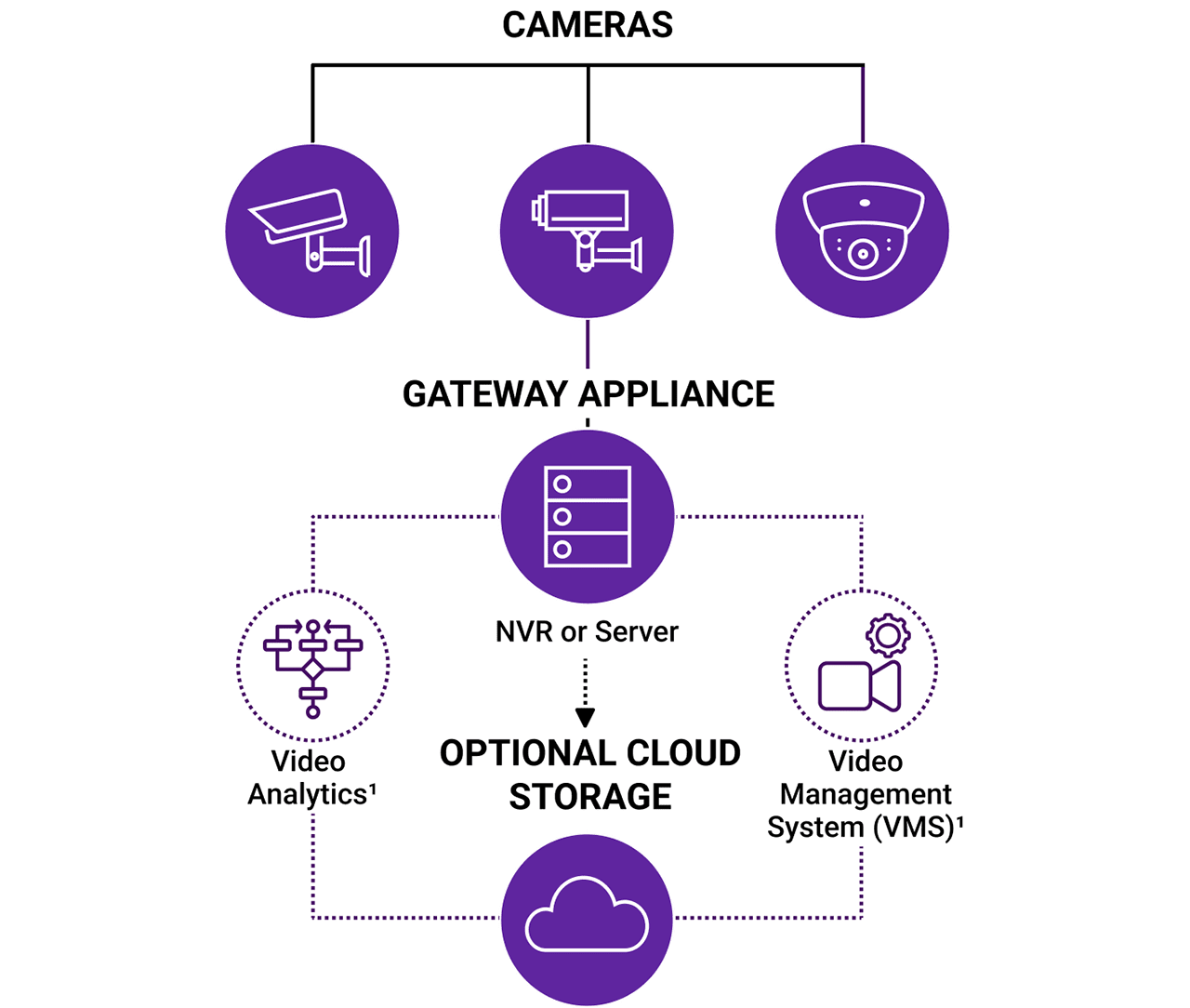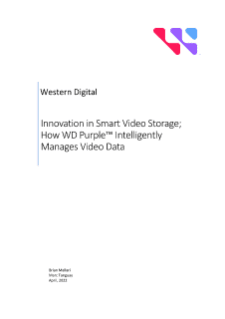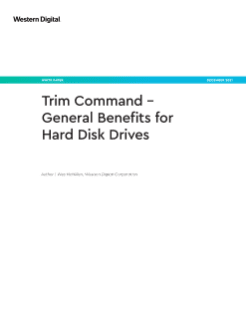Güvenlik Gözetimi ve CCTV için Güvenilir Depolama
Yapay zeka, video analizi ve video yönetim çözümleri için tasarlanan yeni nesil güvenlik gözetimi depolama çözümlerinin gücünü keşfedin.
Her Kare Önemlidir.
Küçük işletmelerden büyük kurumsal kampüslere ve akıllı şehirlere kadar en değerli varlıklarınızı koruyun ve işinizi WD Purple güvenlik gözetimi sabit diskleriyle güvence altına alın. Yüksek sıcaklıkta ve sürekli çalışan güvenlik gözetimi sistemleri için özel olarak tasarlanan WD Purple, en çok ihtiyacınız olduğunda güvenilir, yüksek kaliteli video oynatma sunar, çünkü her saniye önemli olduğunda hepsini kaydederiz.
CCTV ve NVR Depolama için Neden WD Purple Seçilmeli?

Gönül Rahatlığıyla Her Anı Yakalayın
AllFrame™ Teknolojisi, sorunsuz oynatma sağlar ve birden fazla kamerayı zahmetsizce çalıştırır, böylece güvenlik gözetimi sisteminizin en çok ihtiyaç duyduğunuz anda net ve güvenilir video sunacağına inanabilirsiniz.

Daha Uzun Dayanıklılık ve Garanti
WD Purple, zorlu koşullarda 16 yuvaya kadar ana akım DVR ve NVR sistemlerini destekler. Daha da fazla gönül rahatlığı için gelişmiş dayanıklılık ve 5 yıl sınırlı garanti sunan WD Purple Pro'ya yükseltin.

Yapay Zeka ve Analiz için Akıllı Güvenlik
Gelişmiş yapay zeka ve video analizlerinin kolaylıkla üstesinden gelen geleceğe hazır bir çözüm için WD Purple Pro’ya yükseltin. Akıllı güvenlik gözetim sistemleri için tasarlanan WD Purple, sizinle birlikte ölçeklenen görev kritik teknolojisiyle en değerli olanı korur.
WD Purple Güvenlik Gözetimi Disklerini Keşfedin
Sıcaklık dalgalanmalarına, ekipman titreşimlerine, zorlu ortamlara dayanacak şekilde üretilmiştir ve çok çeşitli güvenlik ve yüksek kapasiteli ağ geçidi cihaz sistemleriyle uyumluluk açısından test edilmiştir.

Güvenlik Gözetimi Sisteminiz için Doğru Depolamayı Tahmin Edin
Güvenlik Gözetimi Depolama Kapasitesi Tahmin Aracımızla mükemmel WD Purple HDD’ler bulun. Sadece kamera sayısı, çözünürlük ve kayıt süresi gibi kurulum ayrıntılarınızı girin, depolama ihtiyaçlarınızı hesaplar ve sisteminiz için doğru disk sayısını ve boyutunu bulmanızda yardımcı olur.

NASIL ÇALIŞIR?
Akıllı Bir Güvenlik Gözetimi Mimarisinin İç Yapısı
Burada gösterilen gibi tipik bir ticari güvenlik gözetimi sisteminde, sahadaki güvenlik kameraları tarafından çekilen video görüntüleri bir ağ video kaydedicisi (NVR) veya sunucu olabilen bir ağ geçidi cihazı tarafından iletilir ve kaydedilir.
Bu video verileri sadece ağ geçidi cihazında veya isteğe bağlı olarak (ve ek olarak) bulutta saklanabilir. Video Yönetim Sistemi (Video Management System - VMS) ve video analiz yazılımı, ağ geçidi cihazında ve/veya bulutta bulunabilir.
4K Kameraların ve Yapay Zeka Analizlerinin Güvenlik Gözetimi Depolama Cihazlarınızı Nasıl Aşırı Yüklediğini Öğrenmek için Buraya Tıklayın.
Güvenlik Gözetimi için Videolar, Bloglar ve Kullanım Senaryoları

Güvenilirlik, Yenilikçilik ve Güvenin 10. Yılını Kutluyoruz
Akıllı video güvenlik gözetiminde sektörün ilki ve öncülük edeni
CCTV ve Güvenlik Gözetimi Depolaması ile İlgili SSS
CCTV ve akıllı video gözetim sistemleri, 7/24 çalışma için tasarlanmış depolama alanı gerektiren sürekli video akışları üretir. Standart masaüstü sabit disklerinin aksine, güvenlik gözetimi diskleri yüksek yazma iş yüklerini yönetmek, kare kaybını azaltmak ve dış mekan kasaları veya endüstriyel kurulumlar gibi zorlu ortamlarda güvenilir bir şekilde çalışmak için özel olarak üretilmiştir.
Güvenlik gözetimi ile masaüstü HDD’ler arasındaki farkı merak ediyorsanız bu fark, dayanıklılık ve performans olarak belirtilebilir. Masaüstü diskleri, aralıklı kullanım ve daha hafif iş yükleri için tasarlanmışken WD Purple ve WD Purple Pro gibi güvenlik gözetimi diskleri, birden fazla yayın akışında sürekli video kaydı için optimize edilmiştir.
WD Purple ve WD Purple Pro diskler şu avantajları sunar:
- Çoklu kamera CCTV ve NVR kurulumları için iyileştirilmiş performans
- Sürekli kayıt desteği (7/24 çalışma)
- Yüksek sıcaklıklara ve neme karşı dayanıklılık
- Disk sağlığı izleme (uyumlu sistemlerde kullanıldığında)
İhtiyaçlarınıza uygun akıllı video depolama çözümünüzü bulun
Açıklamalar
- İş yükü Oranı, sabit diske aktarılan veya sabit diskten alınan kullanıcı verileri anlamına gelir. İş Yükü Oranı yıllık olarak hesaplanmaktadır (transfer edilen TB ✕ (8760 / kaydedilen açık saatler)). İş Yükü Oranı, donanım ve yazılım bileşenleriniz ile yapılandırmalarına bağlı olarak değişiklik gösterecektir.
- Bölgeye özel garanti bilgileri için https://www.westerndigital.com/support/store/warranty-policy adresine bakın.





